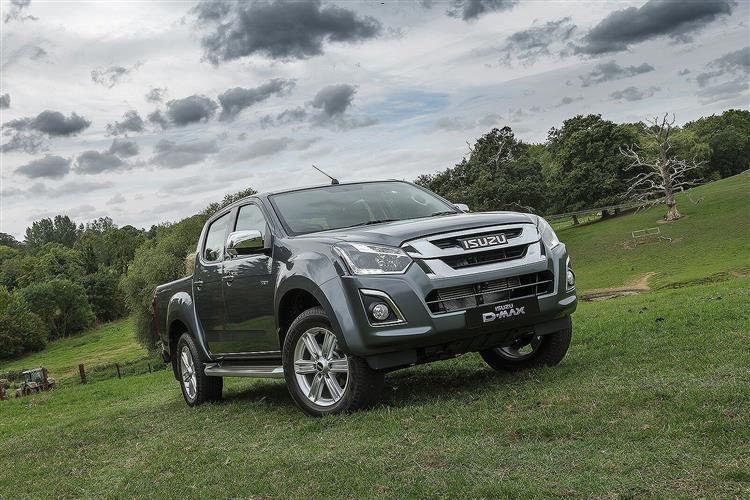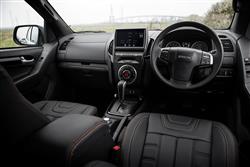How will you view?
This is a sample, showing 30 seconds of each section.
D-PENDABLE (some text hidden) SECTIONED_new_isuzudmax_2017
By Jonathan Crouch
Introductionword count: 60
The Isuzu D-Max has traditionally been the kind of pick-up you'd choose if you wanted one not afraid to put a bit of serious dirt beneath its wheels. The 'RT'-series model was launched in 2012, but here, we look at the version updated with a down-sized 1.9-litre diesel engine, launched in 2017. How does it fare as a used buy?
Modelsword count: 3
1.9 Pick-up (diesel)
Historyword count: 237
Isuzu knew back in 2017 that at first glance, long-time D-Max owners might have a few qualms about switching to this revised version of the 'RT'-series model, a design which by then had been in production for five years. After all, there weren't too many visual changes and the old 2.5-litre diesel engine had been replaced by a down-sized 1.9-litre unit with less pulling power than before. Take a second glance though and the appeal of this much improved package starts to become more obvious. The engine puts out 164bhp, which is virtually the same before, and the small torque deficit was compensated for with revised gearing, which is why this truck's 3.5-tonne towing capacity remained un-bettered in the class. As you'd expect, the 1.9-litre powerplant is far cleaner and more economic than its predecessor. Plus its considerably lighter weight also allows for a useful 50kg payload increase across the range and enables this Isuzu to be driven without the major road speed restrictions which now apply to some of its heavier rivals. Of course, the improvements to his model weren't all about the engine. Buyers also got the option of an updated 6-speed automatic gearbox, slightly smarter looks, a re-designed cabin, stronger standards of safety and a more complete equipment tally, especially when it came to media connectivity. In this form, the 'RT'-series model sold until it was replaced by an all-new 'RG'-series design in 2021.
What You Getword count: 359
Styling hasn't been a priority for Isuzu pick-ups in the past that offered rugged, squarical shapes, big wheels, lots of chrome - and not a lot else. The original version of this 'RT'-series D-Max model moved that philosophy forward a little, with a rather more appealing design originally developed in the wind tunnel of the Japan Railway Research Institute, the place where the famous Bullet Train was born. This shape was further refined here. Most of the changes took place at the front, where the bumper and the bonnet were revised, as has the imposing grille that separates re-styled headlights incorporating LED daytime running lights. There are smarter front fog lamps too. Behind the wheel, in terms of the interior changes made to this revised D-Max model, the instrument panel was re-designed with an updated central display and clearer fonts for the instruments. Infotainment's was also upgraded for this improved model. Avoid the entry-level variants and you get a 7-inch multi-function touchscreen, upgraded in size to 9-inches on the flagship 'Blade' derivative. For rear-seated folk, there's slightly more passenger comfort than is provided by some rival models, thanks to this Isuzu's relatively long wheelbase. This facilitates head, shoulder and leg room and allows the seat back to be less vertically inclined, for greater comfort on longer journeys. One nice touch is the way that 60/40 split-folding rear seat base enables you to more flexibly use this rear passenger space for packages, should you so wish. Time for a few practicalities. Drop down the sturdy tailgate and the headline news is the size of the cargo bay. There's 1,485mm of load bay length in the Double Cab model, a figure that rises to 1,795mm in the Extended Cab bodystyle and 2,305mm with the Single Cab body shape. All variants offer 1,530mm of load bay width and 465mm of load bay depth. That of course makes this area easily big enough for a euro pallet, which can slide in the 1,110mm-wide space between the wheel arches. That might encourage you to carry heavier loads, so it's important that the total payload capacity is usefully high, rated at around the 1.1-tonne mark.
To see the full road test text contact us on 0330 0020 227
Pictures (high res disabled)

.jpg)
|
.jpg)
|
.jpg)
| |||
.jpg)
|
.jpg)
|
.jpg)
| |||
.jpg)
|

|
Scoring (subset of scores)
Category: Pick-Ups
| Performance | |
| Handling | |
| Comfort | |
| Space | |
| Styling, Build, Value, Equipment, Depreciation, Handling, Insurance and Total scores are available with our full data feed. | |



